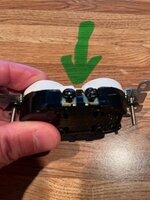SHEP
Well-Known Member
- Joined
- Feb 1, 2008
- Messages
- 1,222
- Reaction score
- 455
I am replacing the outlet under the sink for the disposal and dishwasher. This outlet is very old and I can't figure out the wiring. I am not an electrician nor do I want to be so hopefully someone knows the answer. I have 3 wires in the outlet; red, black, and white. There isn't a bare copper wire for the ground, just those three wires. Which one is the ground? I thought the white one be it but not sure. The back of the old one is so old it doesn't state which wire is for what. In the picture below, showing the back of the old outlet, the bare wire is actually the white wire but the coating came off. On the back of the new outlet, the options on the back are "hot" on one side and "white blanco" on the other. Then there is the green screw for the ground. I thought the white would be the ground but the back is confusing me and I don't know sh*t about anything. What say ye??
Here is the old one, the bare one is actually the white wire:

Here are the wires, sorry for the mess, still cleaning it:

Here is the new outlet which is hard to read but the right side says "hot" and the left with the lighter screws says "white blanco".

Thanks for the help!
SHEP
Here is the old one, the bare one is actually the white wire:
Here are the wires, sorry for the mess, still cleaning it:
Here is the new outlet which is hard to read but the right side says "hot" and the left with the lighter screws says "white blanco".
Thanks for the help!
SHEP




